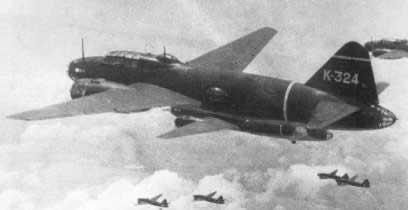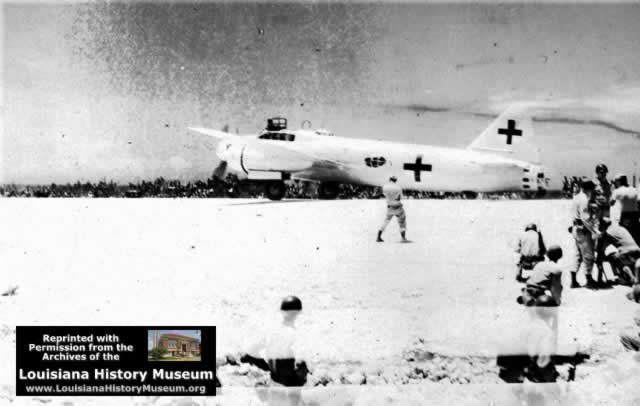Japanese Mitsubishi G4M Betty Bomber
Background on the Japanese G4M Betty Bomber
 Mitsubishi G4M bombers in flight during World War II |
The Mitsubishi G4M was the main twin-engine, land-based bomber used by the Imperial Japanese Navy Air Service in World War II. The Allies gave the G4M the code name "Betty".
The G4M was designed for a long range and high speed at the time, and many weight-saving measures were incorporated into its design. Its top speed was 270 mph, with a range of 2,935 miles.
The G4M Betty is remembered for the ill-fated flight which saw the death of Admiral Yamamoto, downed by a pair of American P-38 Lightnings over Bougainville in 1943. It was referred to as the "Flying Zippo" and "One-Shot Lighter" by Allied fighter pilots due to its lack of protection for its crew, with no armor plating or self-sealing fuel tanks.A total of 2,435 G4M aircraft were manufactured.
The G4M's Role in the Japanese Surrender
After Japanese capitulation at the end of World War II, U.S. Army General Douglas MacArthur instructed the Japanese to send emissaries to Manila to arrange the formal surrender, and bring with them all of Japan's defensive plans. Japanese Army Chief of Staff General Umezu refused to participate, and delegated the mission to General Torashiro Kawabe, who choose fifteen staff members to accompany him.
As part of the negotiations for the surrender, two demilitarized Japanese G4Ms, given the call-signs "Bataan 1" and "Bataan 2," were to be sent to Ie Shima carrying the first surrender delegations on the first leg of their flight to Manila in the Philippines.
The G4Ms were painted in surrender markings, white with green crosses, and were escorted by American P-38 Lightning fighters. The paint scheme was ordered by General MacArthur to verify that the planes were carrying the delegates.
On August 19, 1945 two Betty bombers took off from Tokyo with the Japanese delegation. Both planes were kept under close watch by constant U.S. Army Air Force escorts due to concerns that the delegates might attempt a kamikaze mission under the color of a flag of truce. Two B-25J Mitchells from the 345th Bombardment Group, with two others flying backup, monitored the flight. Providing top cover were six P-38 Lightnings of the 80th Fighter Squadron. The Japanese landed at Ie Shima Airfield at 12:40 in front of a large crowd of Americans gathered to witness their arrival.
Once the planes landed at Ie Shima, the delegates were transferred to a U.S. Army Air Force C-54 Skymaster for the final leg of the flight to Manila to meet with Macarthur to work out the details of the surrender. The two Bettys remained at Ie Shima to transfer the delegation back after the Manila meeting. Both planes were reportedly destroyed either by accident or planned scrapping shortly afterwards.
Shown below is a previously unpublished photo of one of the G4Ms carrying Japanese delegation to the surrender ceremony.
Photo by the Louisiana History Museum
Mitsubishi G4M Betty code name "Bataan" that carried the Japanese surrender delegation on the first leg of the flight to Manila |
 |
Special thanks to the Louisiana History Museum for granting permission
to use this historic photo from its archives

